1类的加载连接和初始化
1.1类的加载过程
类的加载过程简单为分为三步:加载->连接->初始化
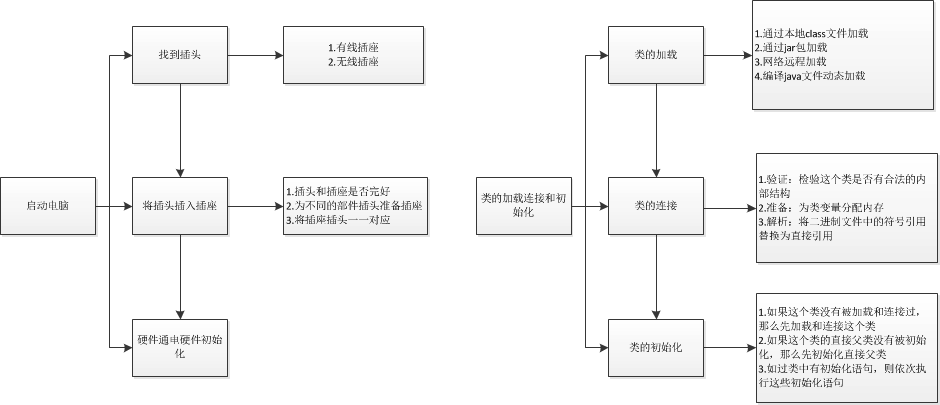
1.2类的加载器
1.2.1类的加载机制
- 全盘加载:
使用一个类负责加载一个Class文件,该Class依赖和负责的Class都由这个类加载器负责加载 - 父类加载:
先让这个类的父类加载器加载这个类,只有当这个父加载器无法加载时候,才从自己的类路径中加载该类 - 缓存机制:
所有被加载过的类都会被缓存,当程序需要某个类的时候,类加载器先从缓冲区寻找这个类,只有当这个类在缓存区不存在时候,才会读取对应的二进制文件,转换为Class对象,所以每次修改了Class后,需要重启JVM才能生效
加载器的继承的顺序,其中自定义的加载器通过继承ClassLoader来实现:

依照这个顺序,可以得到一个类加载的顺序:
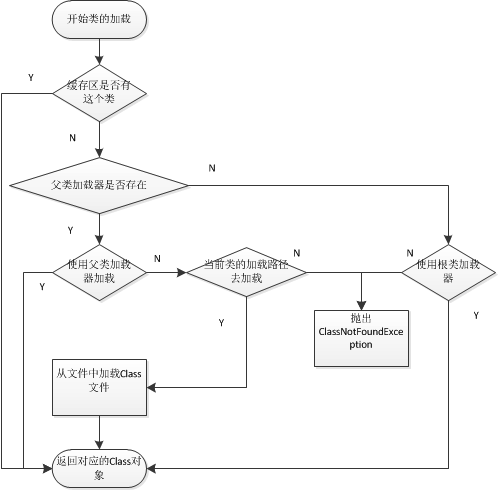
1.通过反射获得类的信息
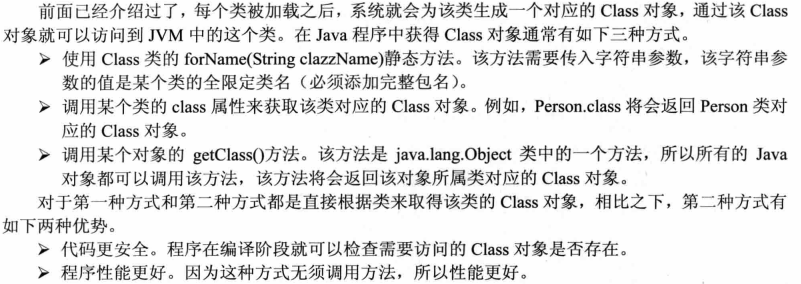
package com.liyue.studycode.classreflect;
import java.lang.annotation.Retention;
import java.lang.annotation.RetentionPolicy;
@Retention(value = RetentionPolicy.RUNTIME)
@interface Anno{}
@SuppressWarnings(value = "unused")
public class BaseClass {
//declare a private constructor.
private BaseClass(){};
//decalre a public constructor
public BaseClass(int id){
System.out.println("excute a public constructor");
}
//delcare a void function
public void fun(){
System.out.println("excute a void function");
};
//declare a function with paramter
public void test(String name){
System.out.println("excute a function with paramter: " + name);
}
}
package com.liyue.studycode.classreflect;
import java.lang.annotation.Annotation;
import java.lang.reflect.Constructor;
import java.lang.reflect.Method;
import java.util.Arrays;
public class RefectMain {
public static void main(String[] args) throws NoSuchMethodException, SecurityException {
//get class's object
Class<BaseClass> cl = BaseClass.class;
//get all public constructor
Constructor[] constructor = cl.getDeclaredConstructors();
System.out.println("All of BaseClass's constuctor:");
for(Constructor c : constructor){
System.out.println(c);
}
//get all public method
Method[] method = cl.getMethods();
System.out.println("All of BaseClass's constuctor:");
for(Method m : method){
System.out.println(m);
}
//get designated method
System.out.println("BaseClass's function with parameter named"
+ "test" + cl.getMethod("test", String.class) );
//get all annotation of BaseClass
Annotation[] an = cl.getAnnotations();
System.out.println("All annotation of BaseClass:");
for(Annotation a : an){
System.out.println(a);
}
//get @SuppressWarnings
System.out.println("BaseClass's SuppressWarnings:"
+ Arrays.toString(cl.getAnnotationsByType
(SuppressWarnings.class)));
//get package
System.out.println("BaseClass's package:"
+ cl.getPackage());
}
}
2.Java 8新增的方法参数反射

如果将上例BaseClass.test方法改造一下:
public void test(String name, int num){
System.out.println("excute a function with paramter: " + name);
}
那么可以这么获取参数
Class<BaseClass> cl = BaseClass.class;
Method m = cl.getMethod("test", String.class, int.class);
Parameter[] ps = m.getParameters();
System.out.println(m.getParameterCount());
for(Parameter p : ps){
System.out.println(p.getName());
System.out.println(p.getType());
System.out.println(p.getParameterizedType());
}
3.通过反射操作对象
3.1创建对象
3.1.1使用newInstance方法

package com.liyue.studycode.objectfactory;
import java.io.FileInputStream;
import java.util.HashMap;
import java.util.Properties;
public class ObjectFactory {
//declare a map to save object
private HashMap<String, Object> objectPool = new HashMap<>();
//declare function to new class,return object by class name
private Object createObject(String targetClassNmae)
throws Exception{
Class<?> cl = Class.forName(targetClassNmae);
return cl.newInstance();
}
//read property file
public void initObjectPool(String fileName)
throws Exception{
Properties pRead = new Properties();
pRead.load(new FileInputStream(fileName));
for(String name : pRead.stringPropertyNames()){
objectPool.put(name, createObject(pRead.getProperty(name)));
}
}
//return object of Map
public Object getObject(String name){
return objectPool.get(name);
}
}
定义一个属性文件,保存需要读取的信息
a = java.util.Date
b = javax.swing.JFrame
package com.liyue.studycode.objectfactory;
public class ObjectFactoryPrint {
public static void main(String[] args) {
ObjectFactory of = new ObjectFactory();
try {
of.initObjectPool("Properties//myclassrelectconfig.ini");
System.out.println(of.getObject("a"));
System.out.println(of.getObject("b"));
} catch (Exception e) {
// TODO Auto-generated catch block
e.printStackTrace();
}
}
}
3.1.2使用Constructor创建

try {
Class<?> cl = Class.forName("javax.swing.JFrame");
Constructor c = cl.getConstructor(String.class);
Object obj = c.newInstance("哈哈");
System.out.println(obj);
} catch (ClassNotFoundException e) {
// TODO Auto-generated catch block
e.printStackTrace();
}
3.2调用方法

package com.liyue.studycode.objectfactory;
import java.lang.reflect.Constructor;
import java.lang.reflect.Method;
public class ObjectFactoryPrint {
public static void main(String[] args) throws Exception{
try {
//call method forName
Class<?> cl = Class.forName("javax.swing.JFrame");
//get constructor
Constructor c = cl.getConstructor(String.class);
//get instance of JFrame
Object obj = c.newInstance("");
//get method setTitle
Method md = cl.getMethod("setTitle", String.class);
//call invoke
md.invoke(obj, "哈哈");
System.out.println(obj);
} catch (ClassNotFoundException e) {
// TODO Auto-generated catch block
e.printStackTrace();
}
}
}
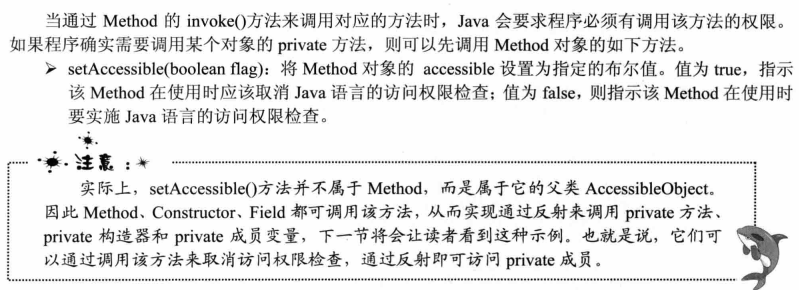
3.3访问成员变量

package com.liyue.studycode.fieldreflect;
import java.lang.reflect.Field;
public class FieldReflectPrint {
public static void main(String[] args)
throws Exception{
Emploee e = new Emploee();
Class<?> cl = e.getClass();
//getDeclaredField get field of the class
/*get name*/
Field nameField = cl.getDeclaredField("name");
//Set the accessible flag for this object
nameField.setAccessible(true);
//set new value
nameField.set(e, "张三");
/*get age*/
Field agefield = cl.getDeclaredField("age");
//Set the accessible flag for this object
agefield.setAccessible(true);
//set new value
agefield.set(e, 29);
System.out.println(e);
}
}
3.4获取数组
4.使用反射生成JDK动态代理

4.1创建动态代理
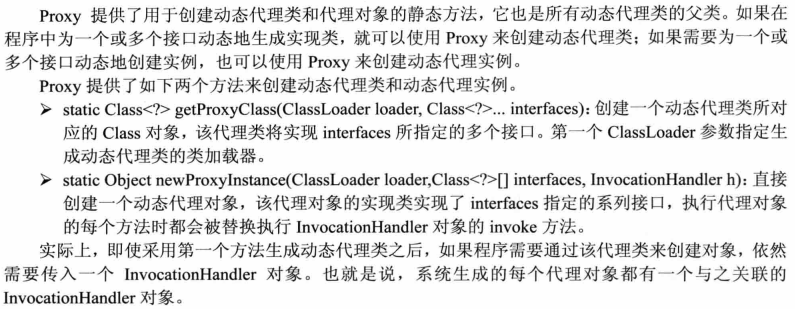
package com.liyue.study.dynamicobject;
import java.lang.reflect.InvocationHandler;
import java.lang.reflect.Method;
public class MyInvokationHandler implements InvocationHandler {
@Override
public Object invoke(Object proxy, Method method, Object[] args) throws Throwable {
if(args != null){
System.out.println("下面是执行该方法时候传入的实参:");
for (Object v : args) {
System.out.println(v);
}
}
else{
System.out.println("调用该方法没有实参。");
}
return null;
}
}
package com.liyue.study.dynamicobject;
import java.lang.reflect.InvocationHandler;
import java.lang.reflect.Proxy;
public class DynamicObjectPrint {
public static void main(String[] args) throws Exception{
InvocationHandler handler = new MyInvokationHandler();
//使用InvocationHandler生成一个动态对象
Person p = (Person)Proxy.newProxyInstance(Person.class.getClassLoader()
, new Class[]{Person.class}
, handler);
p.walk();
p.sayHello("李四");
}
}
4.2动态代理和AOP
package com.liyue.studycode.aop;
public interface Bird {
//definition two abstract function
void info();
void fly();
}
package com.liyue.studycode.aop;
public class Duck implements Bird {
@Override
public void info() {
// TODO Auto-generated method stub
System.out.println("I am a duck!");
}
@Override
public void fly() {
// TODO Auto-generated method stub
System.out.println("I can fly!");
}
}
package com.liyue.studycode.aop;
public class BirdUtil {
//This is the first simulation function
public void fun1(){
System.out.println("This is birdutil function 1!");
}
//This is the second simulation function
public void fun2(){
System.out.println("This is birdutil function 2!");
}
}
package com.liyue.studycode.aop;
import java.lang.reflect.InvocationHandler;
import java.lang.reflect.Method;
public class MyInvocationHandler implements InvocationHandler {
//The object need to agented
private Object target;
//setter
public void setTarget(Object target) {
this.target = target;
}
@Override
public Object invoke(Object proxy, Method method, Object[] args)
throws Exception {
BirdUtil bu = new BirdUtil();
//simulate the first function
bu.fun1();
//use target to excute method
Object result = method.invoke(target, args);
//simulate the second function
bu.fun2();
return result;
}
}
package com.liyue.studycode.aop;
import java.lang.reflect.Proxy;
import com.liyue.studycode.aop.MyInvocationHandler;
public class MyProxy {
public static Object getProxy(Object target)
throws Exception{
//create a MyInvocationHandler
MyInvocationHandler mih = new MyInvocationHandler();
//set target to mih
mih.setTarget(target);
return Proxy.newProxyInstance(target.getClass().getClassLoader()
, target.getClass().getInterfaces()
, mih);
}
}

package com.liyue.studycode.aop;
import com.liyue.study.dynamicobject.MyProxy;
public class AopPrint {
public static void main(String[] args)
throws Exception {
//create a object of Duck
Bird target = new Duck();
Bird b = (Bird)MyProxy.getProxy(target);
b.info();
b.fly();
}
}
有参构造的调用
有一个带参构造:
package pers.liyue.generic.test;
public class ReflectTest {
public int num = 0;
public double size = 0.00;
private float bignum = 0;
public ReflectTest(){
System.out.println("Create class!");
}
public ReflectTest(int numb){
System.out.println("Create class with args!" + numb);
}
}
调用时候不能用默认的newInstance
public static void main(String[] args) throws Exception {
// TODO Auto-generated method stub
ReflectTest rt = new ReflectTest();
rt.Fun1();
//无参构造调用
Class c = Class.forName("pers.liyue.generic.test.ReflectTest");
ReflectTest o = (ReflectTest)c.newInstance();
//有参构造调用
Constructor ccc = c.getConstructor(new Class[]{int.class});
ReflectTest b = (ReflectTest)ccc.newInstance(new Object[]{1});
}